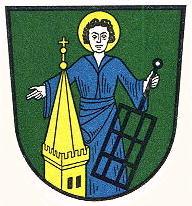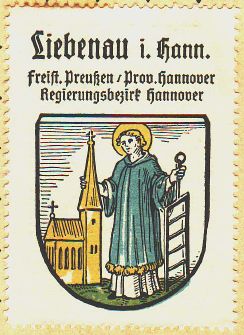Liebenau (Niedersachsen): Difference between revisions
Knorrepoes (talk | contribs) m (Text replace - "The arms in the Kaffee Hag albums +/- 1925 " to "The arms by Hupp in the Kaffee Hag albums +/- 1925 ") |
Knorrepoes (talk | contribs) m (Text replacement - "↵↵'''" to "'''") |
||
| (20 intermediate revisions by the same user not shown) | |||
| Line 1: | Line 1: | ||
<seo title="Wappen von Liebenau" titlemode="append"></seo>'''LIEBENAU''' | |||
'''LIEBENAU''' | |||
State : [[Niedersachsen]]<br/> | State : [[Niedersachsen]]<br/> | ||
| Line 12: | Line 5: | ||
Samtgemeinde : [[Samtgemeinde Liebenau]] | Samtgemeinde : [[Samtgemeinde Liebenau]] | ||
[[File:liebena2.jpg|center]] | [[File:liebena2.jpg|center|Wappen von Liebenau]] | ||
= | {| class="wikitable" | ||
|+Official blazon | |||
|- | |||
|'''German''' | |||
| blazon wanted | |||
|- | |||
|'''English''' | |||
| blazon wanted | |||
|} | |||
===Origin/meaning=== | |||
The arms show St. Lawrence, the patron saint of the town as well as of the smiths, a common profession in the town. The first use of the combination of saint and church is known from 1558, but must be older, as it dates from after the Reformation. The present colours are used since the middle of the 20<sup>th</sup> century, but otherwise the arms have never changed. | The arms show St. Lawrence, the patron saint of the town as well as of the smiths, a common profession in the town. The first use of the combination of saint and church is known from 1558, but must be older, as it dates from after the Reformation. The present colours are used since the middle of the 20<sup>th</sup> century, but otherwise the arms have never changed. | ||
| Line 24: | Line 25: | ||
{|align="center" | {|align="center" | ||
|align="center"|[[File:liebenau-hannover.hagd.jpg|center]] <br/>The arms by [[Otto Hupp|Hupp]] in the [[Kaffee Hag albums]] +/- 1925 | |align="center"|[[File:liebenauhz1.jpg|center|Siegel von Liebenau]] <br/>Seal from around 1900 | ||
|align="center"|[[File:liebenau-hannover.hagd.jpg|center|Wappen von Liebenau]] <br/>The arms by [[Otto Hupp|Hupp]] in the [[Kaffee Hag albums]] +/- 1925 | |||
|} | |} | ||
{{de}} | |||
{{media}} | {{media}} | ||
[[Literature]] : Stadler, 1964-1971, 8 volumes; Kaffee Hag picture albums, 1920s; Ziegler, 1986 | [[Civic Heraldry Literature - Germany|'''Literature''']]: Stadler, 1964-1971, 8 volumes; Kaffee Hag picture albums, 1920s; Ziegler, 1986 | ||
[[Category:German Municipalities L]] | [[Category:German Municipalities L]] | ||
[[Category:Niedersachsen]] | [[Category:Niedersachsen]] | ||
[[Category:Nienburg]] | [[Category:Nienburg]] | ||
Latest revision as of 10:11, 27 December 2023
LIEBENAU
State : Niedersachsen
District (Kreis) : Nienburg
Samtgemeinde : Samtgemeinde Liebenau
| German | blazon wanted |
| English | blazon wanted |
Origin/meaning
The arms show St. Lawrence, the patron saint of the town as well as of the smiths, a common profession in the town. The first use of the combination of saint and church is known from 1558, but must be older, as it dates from after the Reformation. The present colours are used since the middle of the 20th century, but otherwise the arms have never changed.
In the Kaffee Hag albums of the early 20th century the arms were shown in a different colour and slightly different comopsition, see below.
| Seal from around 1900 |
The arms by Hupp in the Kaffee Hag albums +/- 1925 |
This page is part of the German heraldry portal |
Heraldry of the World |
|
German heraldry:
|
Selected collector's items from Germany:
|
Contact and Support
Partners:
Your logo here ?
Contact us
© since 1995, Heraldry of the World, Ralf Hartemink 
Index of the site
Literature: Stadler, 1964-1971, 8 volumes; Kaffee Hag picture albums, 1920s; Ziegler, 1986














